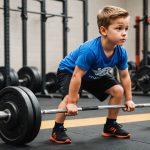Exploring the Impact of AI on Crafting Tailored Training Programs for Runners in the UK
The Evolution of Training Programs: From Human Coaches to AI
In the realm of sports, particularly running, the traditional model of training has long been dominated by human coaches and personal trainers. However, with the rapid advancement of artificial intelligence (AI), the landscape of sports training is undergoing a significant transformation. AI is now being harnessed to create highly tailored and efficient training programs, offering runners in the UK a new and innovative way to enhance their performance.
The Role of AI in Sports Training
AI in sports training is not just about replacing human coaches but rather about augmenting their capabilities. For instance, AI can analyze vast amounts of data, including performance metrics, injury prevention strategies, and real-time feedback, to provide athletes with personalized training plans. This is particularly evident in the global AI in sports market, which is expected to grow exponentially, driven by demands for performance optimization, fan engagement, and injury prevention.
In parallel : Top Recovery Techniques for UK Marathon Runners: Essential Cooling Down Strategies Post-Race
Anna Kaleb, who tested an AI-driven fitness application, highlighted the importance of AI in keeping workouts engaging and varied. “The app is quite innovative, featuring a virtual instructor demonstrating exercises on-screen. I appreciated the variety of workouts along with video tutorials,” she said. However, she also noted the limitations of AI, emphasizing that “AI cannot replicate the accountability provided by a personal trainer”.
How AI Analyzes Data to Enhance Athlete Performance
One of the key strengths of AI in sports training is its ability to analyze large datasets to provide insightful information. Here are some ways AI uses data to enhance athlete performance:
Topic to read : Essential Elements for Crafting a Winning Sponsorship Proposal for UK Minor League Football Teams
- Performance Metrics: AI can track and analyze various performance metrics such as speed, distance, heart rate, and other physiological data. This helps in identifying areas for improvement and optimizing training programs.
- Injury Prevention: By analyzing historical data and real-time feedback, AI can predict potential injuries and suggest preventive measures. For example, wearable devices can monitor an athlete’s activity levels and alert them to take rest days or modify their training to avoid overexertion.
- Real-Time Feedback: AI-powered sports apps can provide immediate feedback on an athlete’s form, technique, and performance during training sessions. This real-time analysis helps athletes make adjustments on the spot, improving their overall performance.
- Personalized Training Plans: AI algorithms can create customized training plans based on an athlete’s specific needs, goals, and current performance level. This personalized approach ensures that each athlete receives a tailored program that maximizes their potential.
Applications of AI in Running Training
AI is being applied in various ways to enhance running training programs:
Game Planning and Strategies
AI can help runners plan their training schedules and strategies more effectively. For instance, AI can analyze weather conditions, terrain, and the athlete’s historical performance data to suggest the best routes and times for training.
Performance Improvement
AI-powered analytics can identify patterns in a runner’s performance data that may not be immediately apparent. This can help in fine-tuning training programs to focus on areas that need improvement, such as endurance, speed, or recovery.
Injury Prevention
AI-driven systems can monitor a runner’s biomechanics and physiological data to predict and prevent injuries. For example, if an AI system detects abnormal stress patterns on the runner’s joints, it can recommend adjustments to the training plan to reduce the risk of injury.
Sports Recruitment
While more relevant to team sports, AI can also help in identifying and recruiting talented runners. By analyzing performance data from various sources, AI can identify potential athletes who may excel in running events.
Table: Comparing Traditional and AI-Driven Training Programs
| Aspect | Traditional Training Programs | AI-Driven Training Programs |
|---|---|---|
| Personalization | Limited to coach’s expertise and time | Highly personalized based on vast data analysis |
| Data Analysis | Manual and time-consuming | Automated and real-time |
| Injury Prevention | Based on coach’s experience | Predictive analytics using historical and real-time data |
| Feedback | Delayed and subjective | Immediate and objective |
| Cost | Often expensive due to coach’s fees | More affordable with subscription-based models |
| Accessibility | Limited by coach’s availability | Accessible anytime, anywhere through apps and devices |
| Engagement | Can be monotonous without variety | Offers varied and engaging workouts with virtual instructors |
The Future of AI in Running Training
As AI technology continues to evolve, we can expect even more sophisticated applications in running training. Here are some trends and future developments:
Generative Models
Future AI systems may use generative models to create entirely new training programs based on the athlete’s performance data. These models can generate novel workout routines that are both challenging and safe.
Neural Networks
Neural networks will play a crucial role in analyzing complex data sets to provide deeper insights into athlete performance. This can help in developing more accurate predictive models for injury prevention and performance improvement.
Integration with Wearable Technologies
The increasing demand for wearable devices will further integrate AI into real-world sports applications. Wearables will collect more detailed data, which AI can analyze to provide real-time feedback and adjustments to the training program.
Practical Insights and Actionable Advice
For runners looking to incorporate AI into their training, here are some practical tips:
- Choose the Right App: Select an AI-powered sports app that aligns with your specific needs and goals. Look for apps that offer personalized training plans, real-time feedback, and injury prevention features.
- Use Wearable Devices: Invest in wearable devices that can track your performance metrics and provide data to AI systems for analysis.
- Stay Engaged: Use AI-driven virtual instructors to keep your workouts varied and engaging. This can help prevent monotony and keep you motivated.
- Understand Data Protection: Ensure that the AI system you use prioritizes data protection. This is crucial for maintaining the privacy and security of your personal and performance data.
- Combine with Human Coaching: While AI is powerful, it is not a replacement for human coaching. Combine AI-driven training with occasional sessions with a human coach to get the best of both worlds.
Quotes from Experts
- “AI can’t replace the accountability you get from a personal trainer,” said Anna Kaleb, emphasizing the importance of human interaction in training.
- “Surgeons are a lot like high-performance athletes,” noted Shan Jegatheeswaran, highlighting the parallels between medical training and sports training, both of which benefit from AI-driven analysis.
Navigating the Balance Between AI and Human Coaching
While AI offers numerous benefits, it is essential to maintain a balance between AI-driven training and human coaching. Here’s why:
Social Engagement
Human coaches provide a level of social engagement and accountability that AI systems currently cannot replicate. “I wouldn’t want AI to take over human roles in the fitness industry because trainers help keep you motivated,” said Anna Kaleb.
Emotional Support
Coaches offer emotional support and a supportive environment where athletes can discuss personal issues, which is a significant aspect of in-person training. “You can’t confide in your AI trainer about a breakup, job stress, or political views,” explained Jill Brown, a certified functional fitness and nutrition coach.
Expert Advice
Human coaches bring a level of expertise and real-world experience that AI, while powerful, cannot fully replace. “AI technology improves, individuals will gain access to high-quality training programs, but there is still a need for human coaches,” noted Jill Brown.
The integration of AI into running training programs is a game-changer for athletes in the UK. With its ability to analyze vast amounts of data, provide real-time feedback, and create personalized training plans, AI is set to revolutionize the way runners train. However, it is crucial to maintain a balance between AI-driven training and human coaching to ensure that athletes receive the best possible support and motivation.
As we look to the future, the potential of AI in sports training is vast and exciting. With continued advancements in technology, we can expect even more sophisticated and effective training programs that combine the best of AI and human coaching. Whether you are a seasoned athlete or just starting out, embracing AI in your training can help you achieve your goals and reach new heights in your running career.











